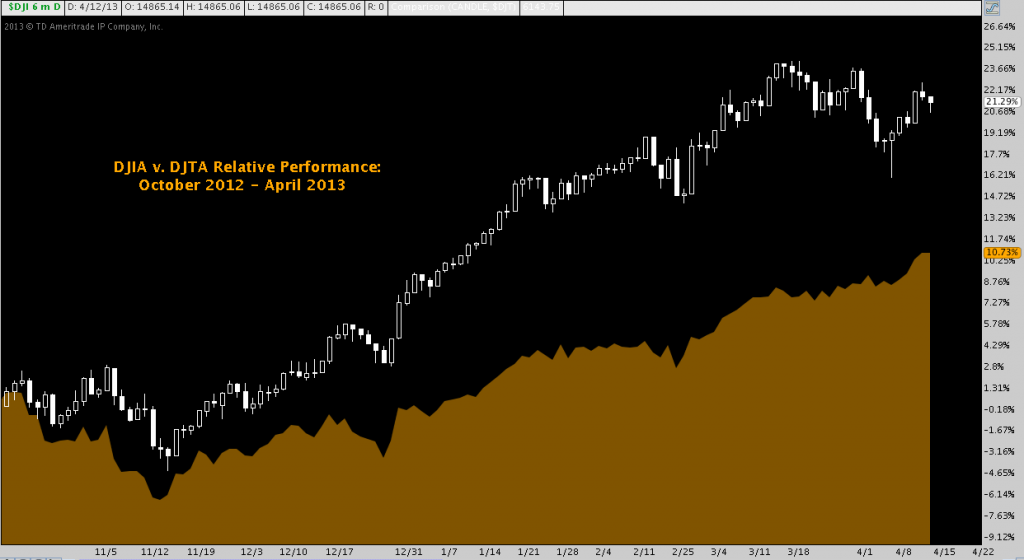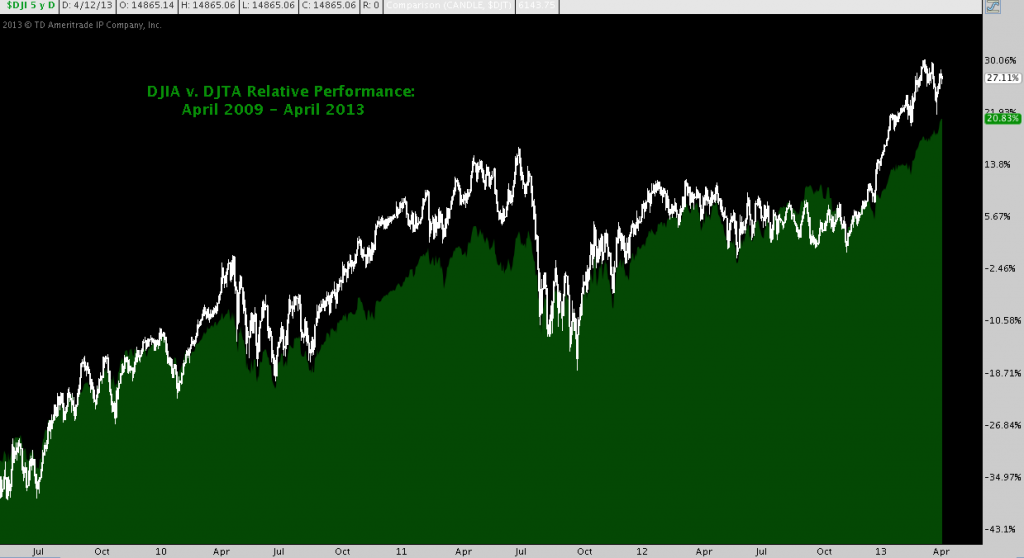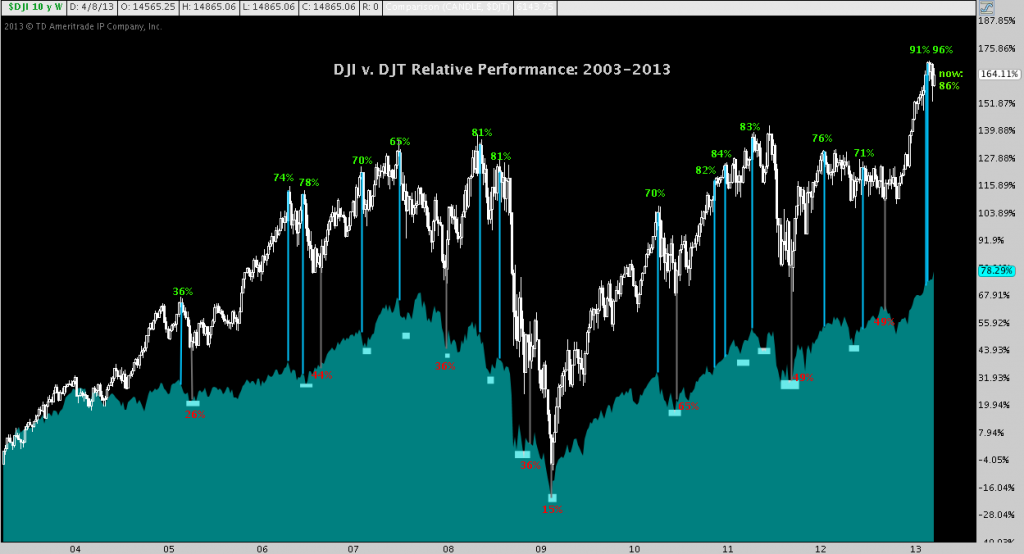 By Andrew Kassen The Dow Transports outperform; but just don’t get much play.
By Andrew Kassen The Dow Transports outperform; but just don’t get much play.
Once referred to simply as the “Rails” because of the historic prevalence of railroads and the prominent status of their stocks (9 of the 11 issues in its original makeup), today the 20-component Dow Jones Transportation Average (DJTA) is composed largely of airlines, trucking, and broader logistics companies – and still includes a few railroads (now 4 of 20).
That’s not “the Dow” the reticent IT guy at work thinks of as he reads his quarterly 401k statement – now in quiet celebration after getting back to break-even last year.
Or the shifty-eyed, slick-and-smarmy car salesman in the BMW showroom last week (chatting you up on that low Euro/German export thing – using his finance degree, somehow – in between shuttling back and forth between you and his sales manager).
Or your kid’s soccer coach (though paper portfolio gains have her feeling more lacrosse coach-like these days). Or the pond-scum-espresso-producing barista you somehow have the continued misfortune of getting in the mornings (her degree didn’t provide a marketable skill, so she’s working on this one while paying the other one off…and plans to go backpacking in Europe with the special dividend she’s knows is coming on that AAPL purchased in September 2012).
For a hundred different reasons – most of them terrible – whenever they think of the market, they’re thinking of the “real” Dow (i.e. the Dow Jones Industrial Average).
Ask them whether the Dow Transports outperform the world’s benchmark of economic vitality. Mention of the index – “So…Transports: that’s a thing?” – may elicit a blank, searching stare. Or among the more social adept, behavioral cues of feigned interest will be deployed as the left side of their brain strategizes about how to most amicably change the subject.
Maybe they should reconsider.
From its November 15, 2012 low at 12542 to its all-time high on April 11th of 14865.14, the Dow Jones Industrial Average (DJIA) steadily climbed, putting in a cumulative gain of 15.6%.
By just about any measure (omitting market responses to overt and implicit efforts at currency destruction), that’s a formidable 4.5 month rally.
That is, unless its stacked up against the Dow Jones Transportation Average (DJTA). Over a similar period (from its 11/16/12 low – 03/14/13 all-time high), the DJTA ripped 22.1% on a closing basis from 4891 to 6281. On a relative basis then, over the period highlighted Dow Transports outperform the more famous Industrials complement by 50%.
Market observers (not all, as we’ve seen; but more than a few) took notice.
For what seems like the first time in a long time (of course most market participants have a memory so short even the guy in Memento – who incidentally moonlit as a day trader after his accident – would turn down), the Dow Transports outperform and people other than Richard Russell and those musing over the merits of Dow Theory paid attention.
Here’s the gist of what they’re seeing (click chart to zoom):
This chart considers a slightly larger timeframe, but the performance statistics are almost identical. Over the last 6 months, the Dow Transports outperformed the Dow Industrials by 10.5%. Actually, “outperformed” is a euphemism: as well as the bellwether DJIA did, DJTA components obliterated it. And oddly, with no “Fed’s manipulating the Trannies!” screed around. 10.5%! Now you’re happy about the idea of paying for carry-on by weight and only being served those damnable windmill-shaped pretzels all the way to de Gaulle!
Well, you would be: if you had given a thought to the Transports. You and your wife’s OB/GYN (those 4-D ultrasounds pay bank that they’re plowing right back into some “highly discounted but sound Biotech value plays”). Your Congressman/woman (attending a closed-session insider-info-laden defense briefing as this goes to press). The guy on CNN with $20,000 veneers (remember: in the New Normal economy, laser-refracting teeth are de rigueur). And Maria Bartiromo (“CNBC”).
Surely there would be more commotion regarding this – newsletter writers be writing newsletters and have to eat too, you see? – if this were a recurrent theme within the 65-stock Dow Composite, right? 6 months is a brief look-back period. Maybe this move is more anomaly than market axiom.
To test that further, let’s check out the last 5 years, a period catching all but the first month of the post-crisis recovery period (click image to zoom):
Still impressive, the Dow Transports outperform the DJIA over this period by 6%+ (even railroads can’t obliterate all the time). Check out the current spread between the two indices: compared to early 2010 and early 2012, it’s dramatically wider. Today’s gap even gives mid-2011 a serious run for its money (more on this a bit further below).
Though this chart makes evident DJTA isn’t as magnificently superior as the last 6 months initially suggest, it does point out an abiding relationship. Transports spend periods of varying length tracking closely with the Industrials, intermediated by other periods in which DJTA very handily trounces DJIA. For example, note the long tracking period from April 2009 to February 2010. Suddenly DJTA begins to separate until it virtually blows off in April 2010, subsequently falls back to earth in a spectacular cessation-of-QE1 decline. Other outperformance periods are rather lengthy – August 2010 to July 2011, a.k.a. QE2 – but end similarly. Both of the periods noted finish in a bottoming consolidation where relative performance among these Dow indices becomes balanced.
The last 5 years have been extraordinary. Maybe too extraordinary. So let’s throw back even further to the heady pre-crisis days of no-doc mortgages, iPod clickwheels and Dow 12000…the second time. (click image to zoom)
As of Friday’s close, the Dow Transports outperformed the Dow Industrials by 86% over the last 10 years. When the DJTA installed its own all-time high a few weeks ago, that disparity reached its own high of 96%.
I’m under no illusions: American hip-hop royalty visiting Cuba with absolute impunity this is not. (Sidebar disclosure: History is currently short HUAC; also portly, bald Slavs repeatedly beating podiums with shoes). But, it is significant enough to unpack further:
- Again: 86%.
- The Dow Transports routinely outperforms to downside as well as the upside: consider the great disparity in 2008; and then the compression between the indices in 2009. DJTA’s rise was far more spectacular; but its decline dwarfed that of DJIA (and I don’t mean cool-dwarf like this guy). In a word: volatility.
- The DJTA’s float above the DJIA has acted like a kind of volatility rubberband, featuring periods of compression (gray vertical lines and corresponding red values denote the tightest local performance spread)followed by yawning gaps. It is during these latter periods in which the Dow Transports outperform 60, 70, 80%+ cumulatively.
- The current period features the widest performance disparity between these indices in at least the last 10 years. Even after the 10% tightening (i.e. DJTA underperformed DJIA) of the past few weeks, the spread remains wider than any other period considered.
- Historically, these gaps have produced corrections – and correlated tightly with DJIA corrections – often in short order. Other times (e.g. late 2010, beginning of 2012), outlying values occur in succession, usually in topping patterns many weeks in the making.
- Sometimes – e.g. 2008 and 2011 – The Transports will make higher highs while the Industrials make lower highs in an example of non-confirmation that has historically presaged corrections. These divergences can also take many weeks to develop.
- All of these outlying values produced downturns that were bought – even 2008 – though the pain is occasionally deep and of significant duration
I haven’t yet conducted more sophisticated regression analysis to answer how the degree of disparity impacts the depth/height of the correction/rally; nor what the relevant degrees are (if any), statistically . Also, I haven’t yet run performance scenarios to determine performance after these spread extremes, though its evident shorts do quite well. And just to be clear: I’m not doing anything so bold here as defending or denouncing a causal relationship between these indices (i.e. endorsing or denying part of Dow Theory). At least, not a tidy, codifiable one.
What do you think: do “blowoff” moves in Dow Jones Transportation Average out-performance (not necessarily the index itself) versus the Dow Jones Industrial Average signal market corrections? If so, is the historically broad disparity underway now one of those occasions?
Twitter: @andrewunknown and @seeitmarket
No position in any of the mentioned securities at the time of publication.
Any opinions expressed herein are solely those of the author, and do not in any way represent the views or opinions of any other person or entity.










